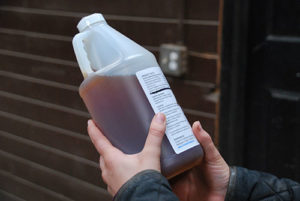How to Bathe a Horse Like a Pro
Learn how to bathe a horse from Mari Valceschini, an FEI dressage competitor and assistant trainer at Natalie Perry Dressage, in Bend, Oregon.
- Topics: Basic Care, Grooming, Horse Care, Media, Slideshow
Share
ADVERTISEMENT
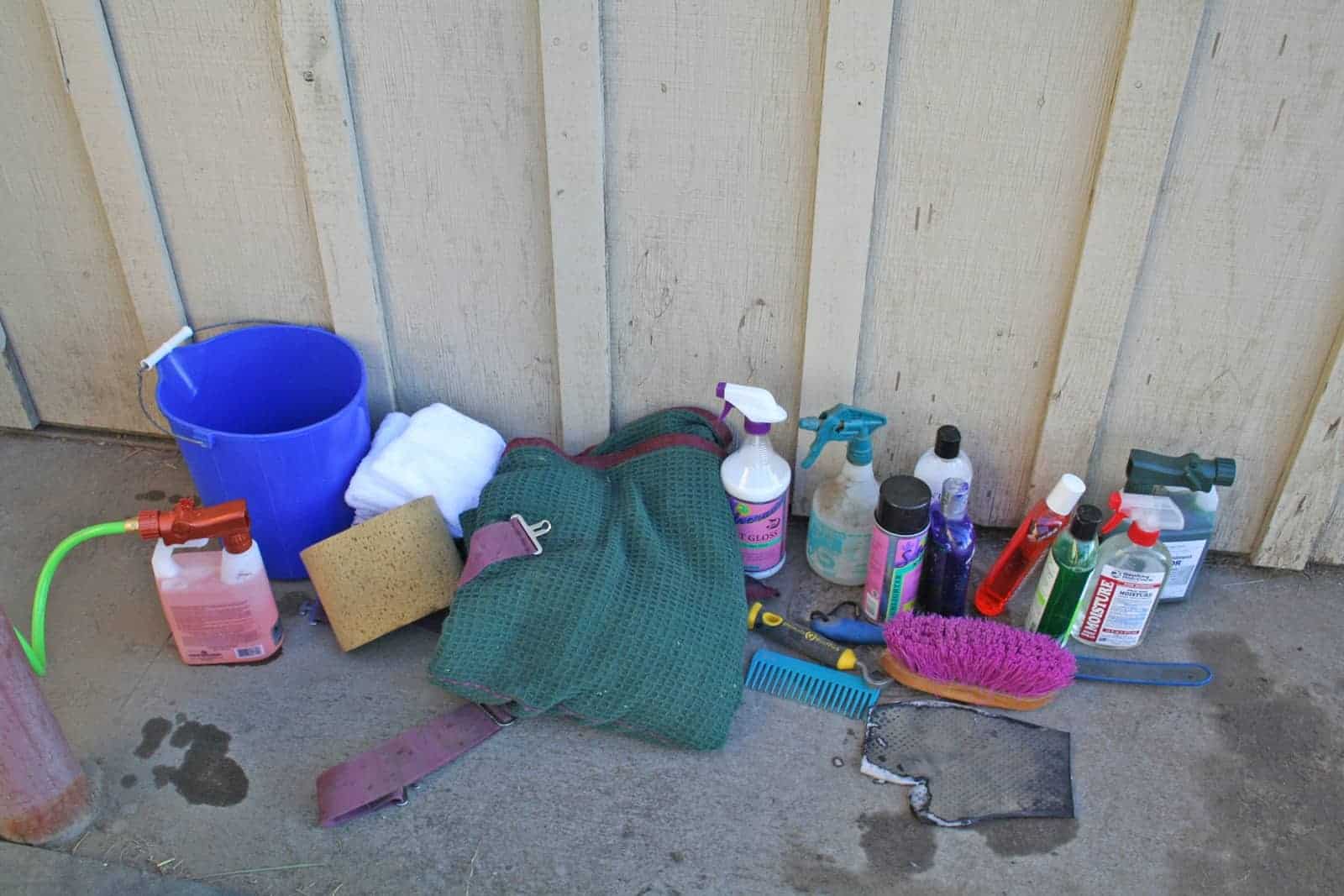
Build Your Horse Bathing Kit
Here are some tools and supplies you might use when bathing your horse: A rubber mitt or curry, body wash, mane and tail shampoo, bluing shampoo (if your horse has white markings), mane and tail conditioner, coat conditioner, coat polish, mane and tail comb, hoof pick, bucket, sponge, clean rags, cooler or sheet, sprayer, dandy brush, and sweat scraper. | Photo: Michelle N. Anderson, TheHorse.com Digital Managing Editor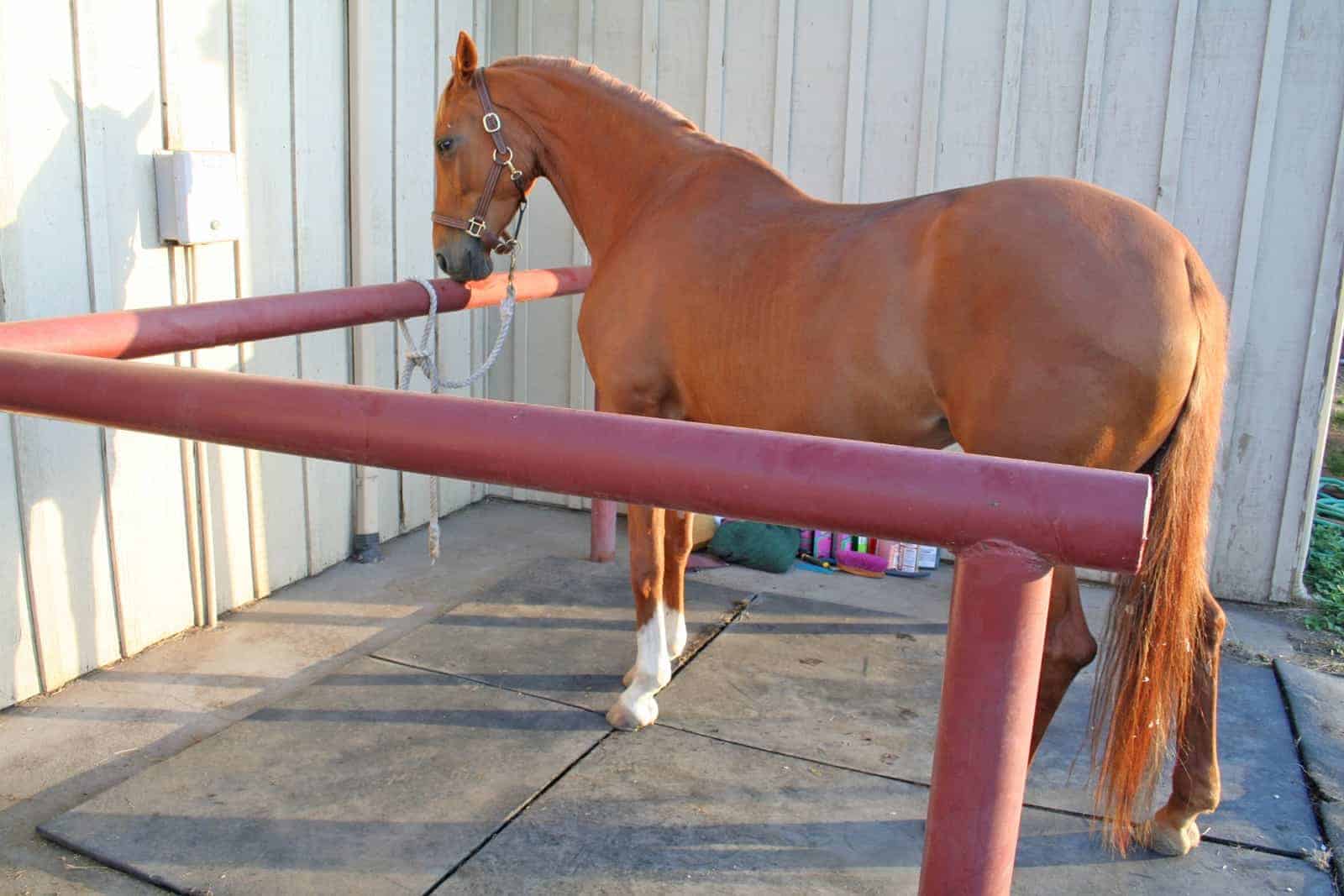
Find a Skid-Free, Mud-Free Surface
The best place to wash a horse has a surface that won’t become a mud puddle when wet. You also want a safe place to wash your horse that will drain water and won’t become slick when wet. Gravel, textured concrete, or rubber mats, such as the ones in this outdoor wash rack, will prevent horses from slipping during washing. It will also prevent the formation of mud, which can be counterproductive when cleaning a horse. | Photo: Michelle N. Anderson, TheHorse.com Digital Managing Editor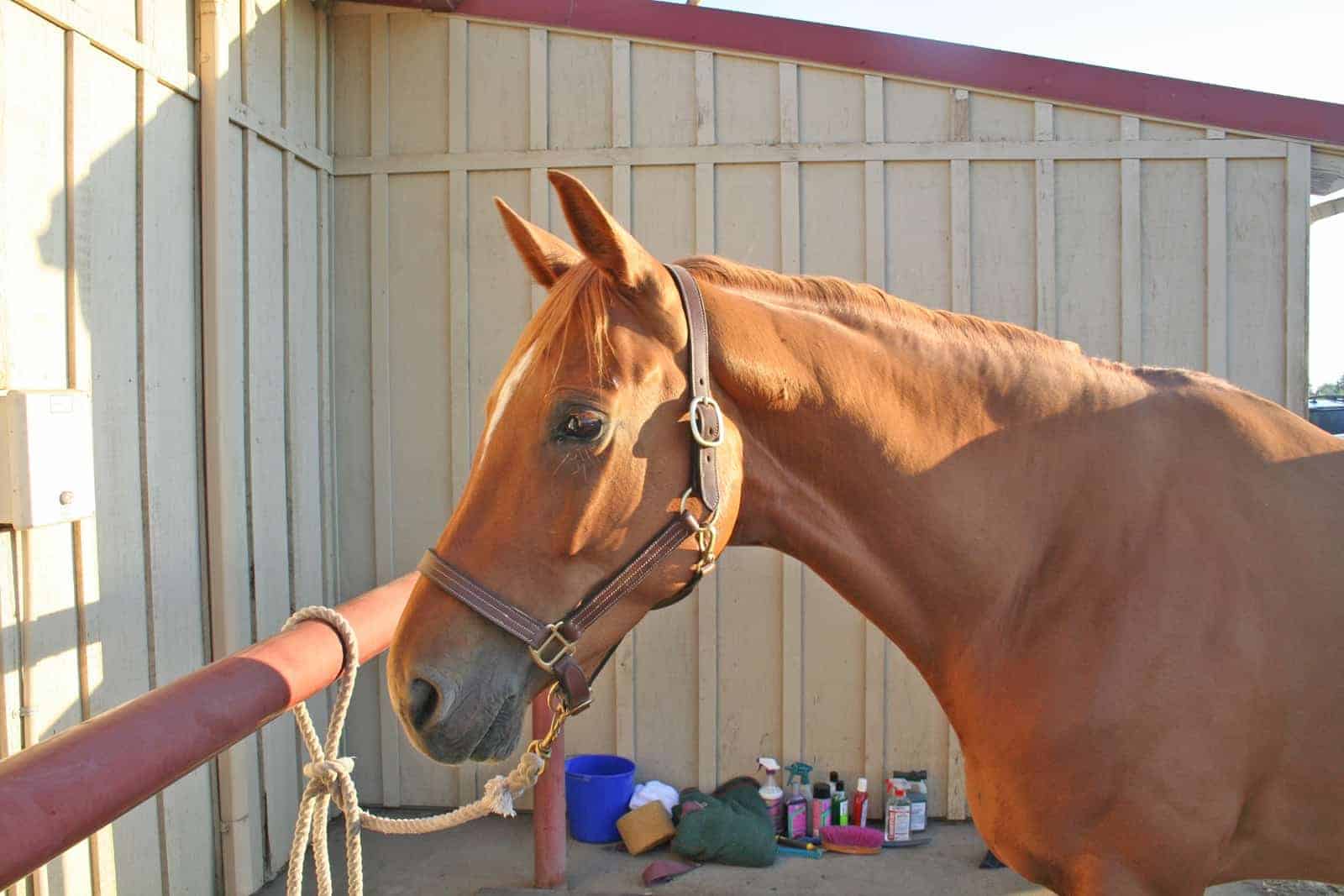
Find a Helper, or Safely Secure Your Horse
Horses that aren’t used to baths might require an extra handler. Horses trained to stand for baths can be tied, but make sure you use a quick-release hitching knot as shown or, if using cross-ties, quick-release snaps. | Photo: Michelle N. Anderson, TheHorse.com Digital Managing Editor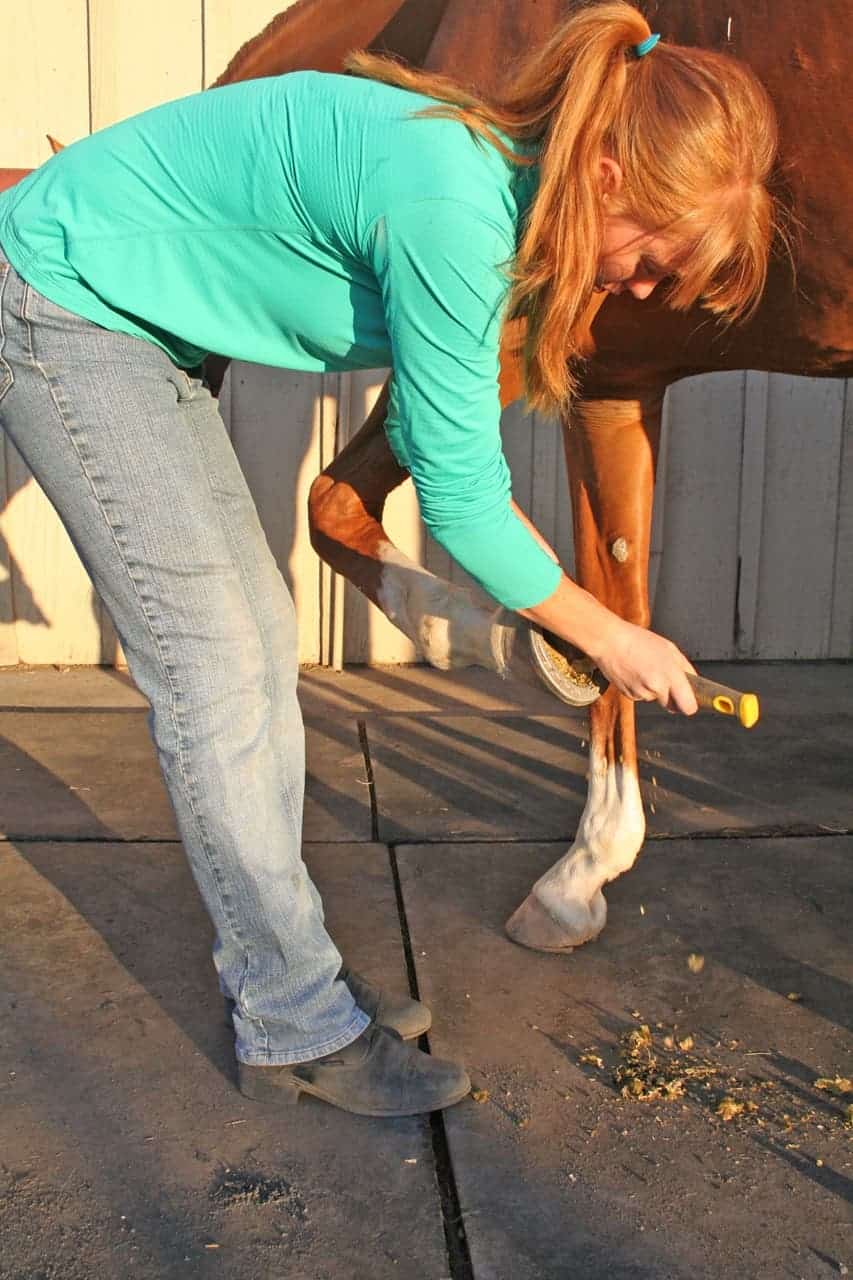
Pick Your Horse's Feet
Before turning on the water, clean out your horse’s feet to prevent dirt and manure from dirtying your wash rack during the bath. | Photo: Michelle N. Anderson, TheHorse.com Digital Managing Editor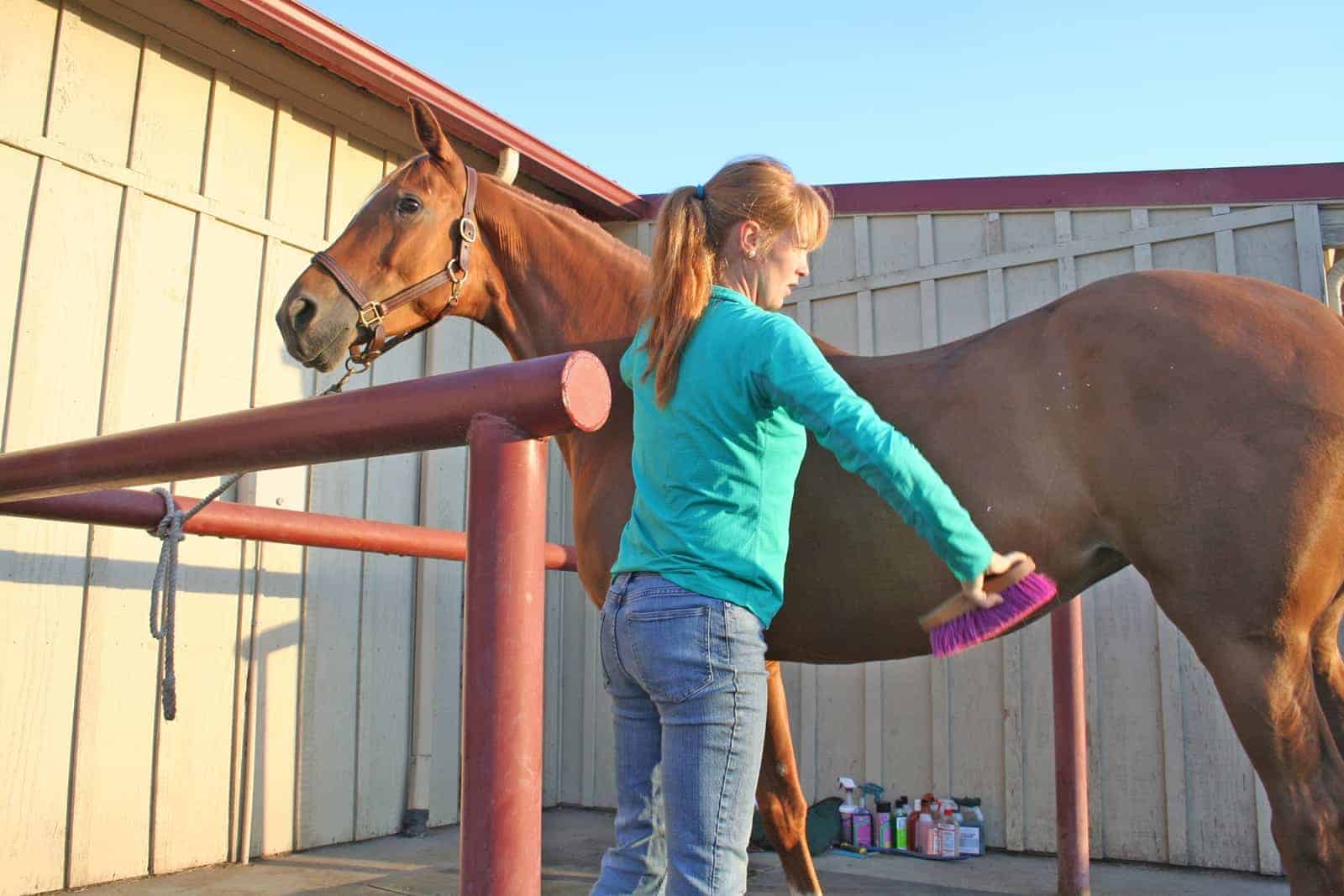
Brush Off Obvious Dirt and Bedding
Brush off any dry shavings or dirt prior to bathing, so that it doesn’t turn into mud when it gets wet. | Photo: Michelle N. Anderson, TheHorse.com Digital Managing Editor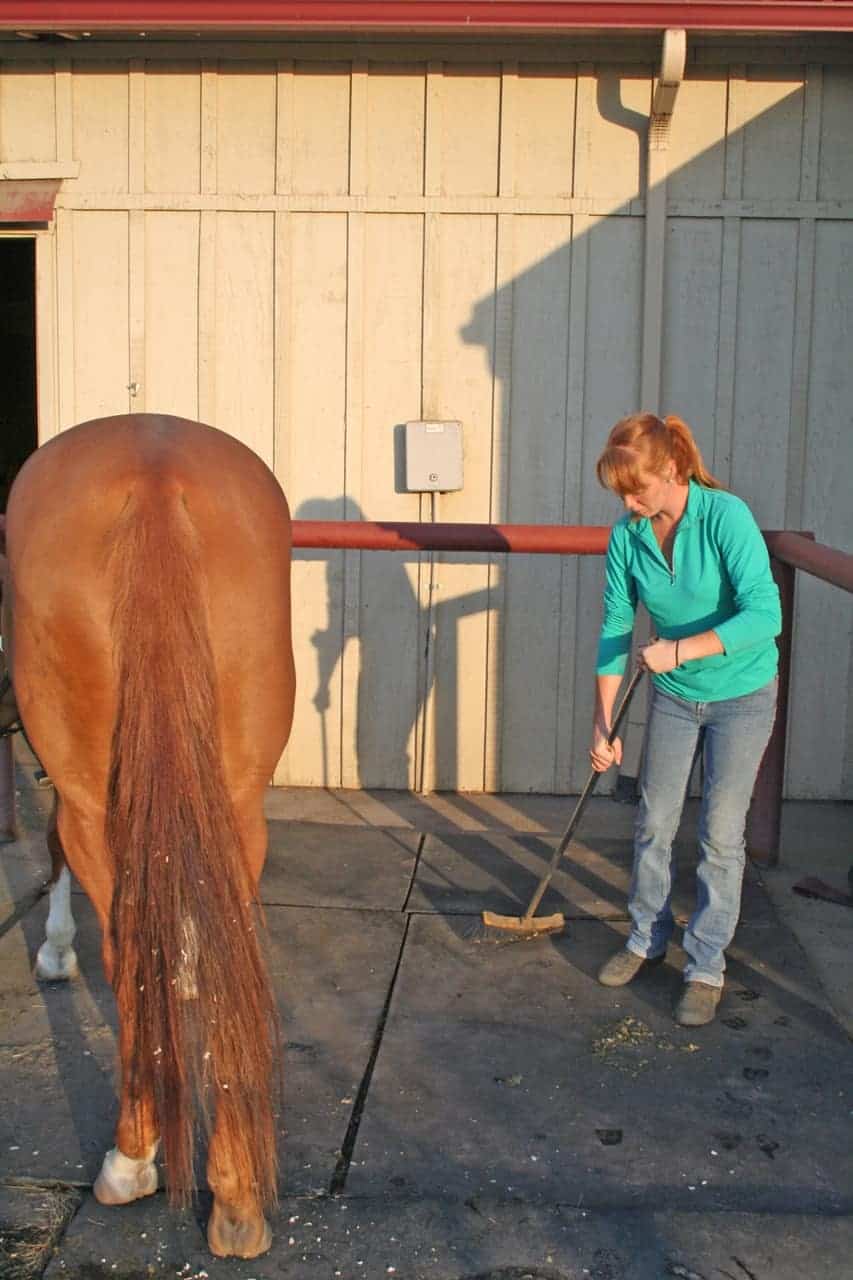
Sweep
If working on mats or concrete, give the ground a good sweep before bathing to ensure you have a clean working surface. | Photo: Michelle N. Anderson, TheHorse.com Digital Managing Editor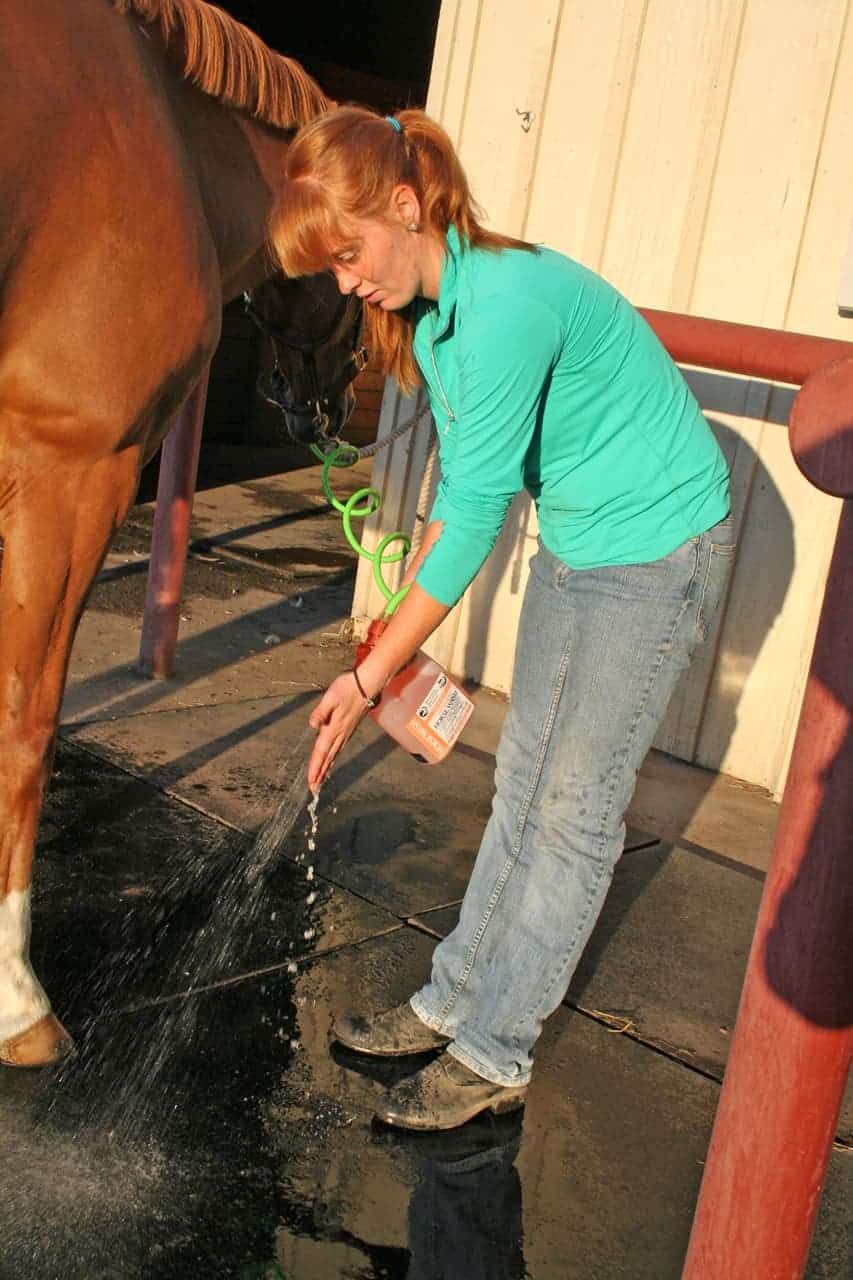
Check the Water Temperature
If you're using warm water, test the temperature with your hand before starting to rinse your horse. Mari prefers water that is comparable to the ambient temperature. To avoid scalding your horse’s skin, check the water temperature periodically to make sure it hasn’t fluctuated. | Photo: Michelle N. Anderson, TheHorse.com Digital Managing Editor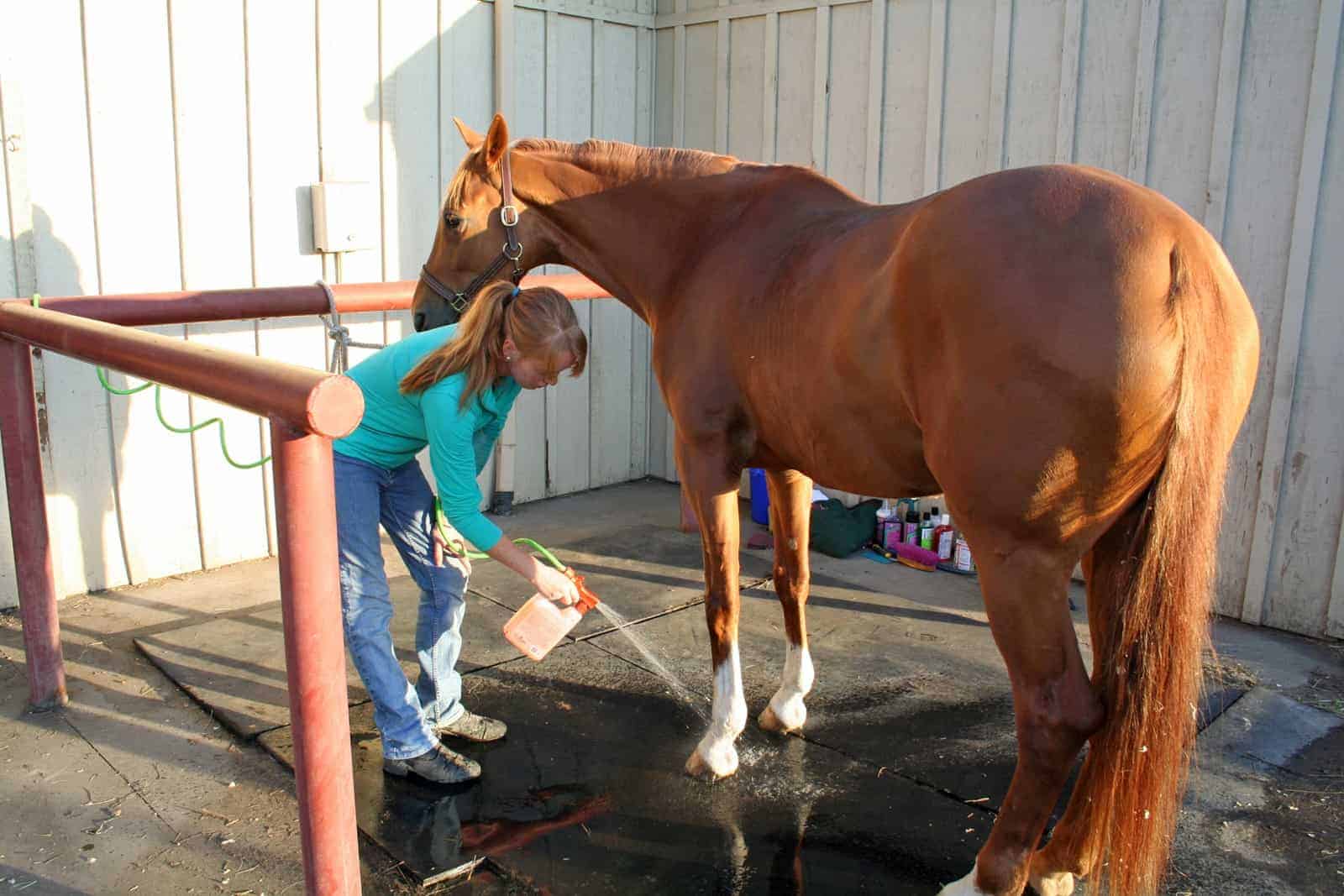
Start Spraying Low and Work Your Way Up
You want to ensure your horse is comfortable with being sprayed, so introduce the water on an area of the body where she's least likely to react. Mari starts at Posey's front hoof and works up to her shoulder, using soothing words to reassure the young mare. | Photo: Michelle N. Anderson, TheHorse.com Digital Managing Editor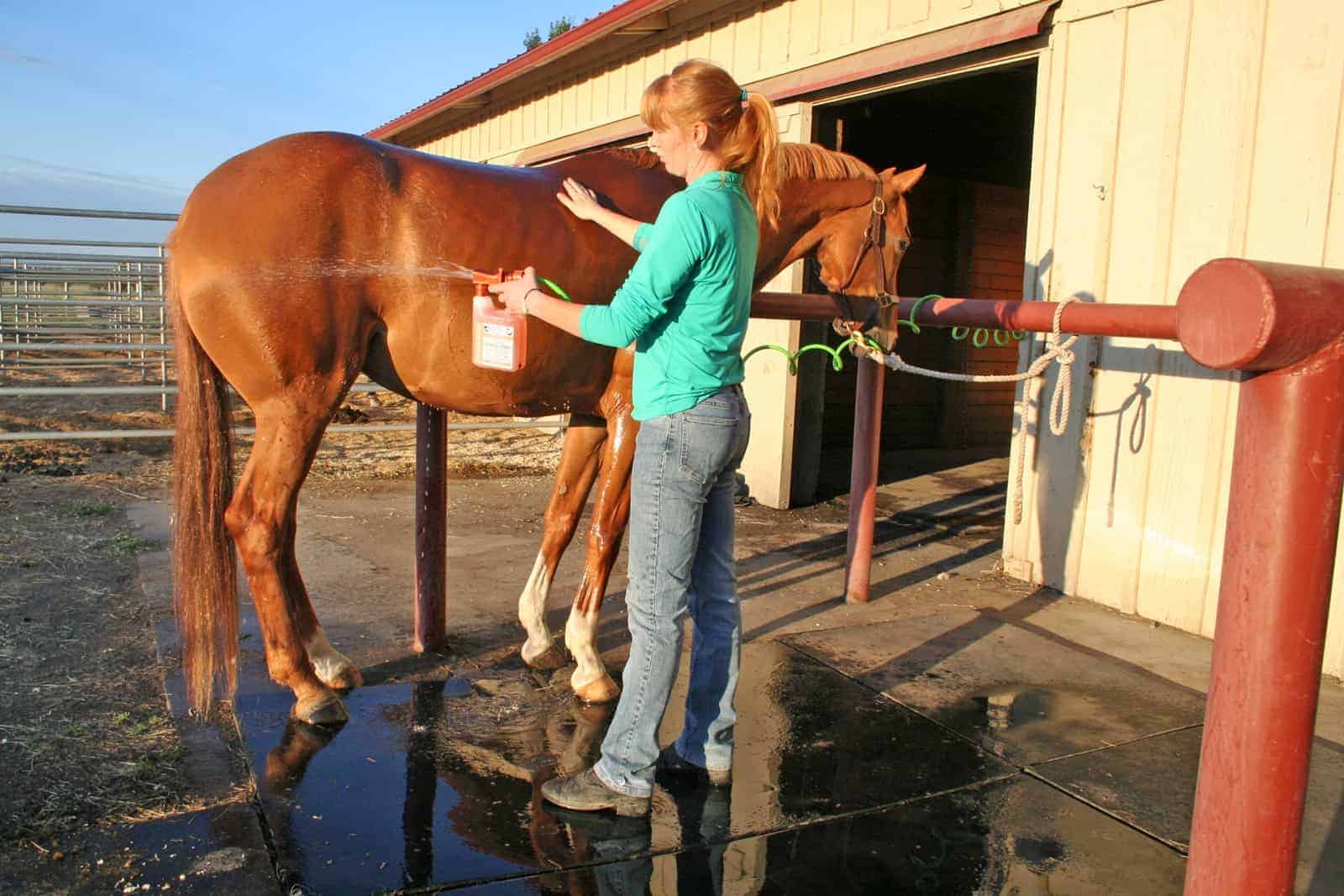
Pre-Rinse
Rinse your horse's entire body, including the mane and tail, before applying shampoo. Put your hand on the horse if she feels uncomfortable, and watch that you position yourself so that the horse can’t strike or kick you. If your horse doesn’t settle, consider seeking the advice of a professional trainer or equine behaviorist. | Photo: Michelle N. Anderson, TheHorse.com Digital Managing Editor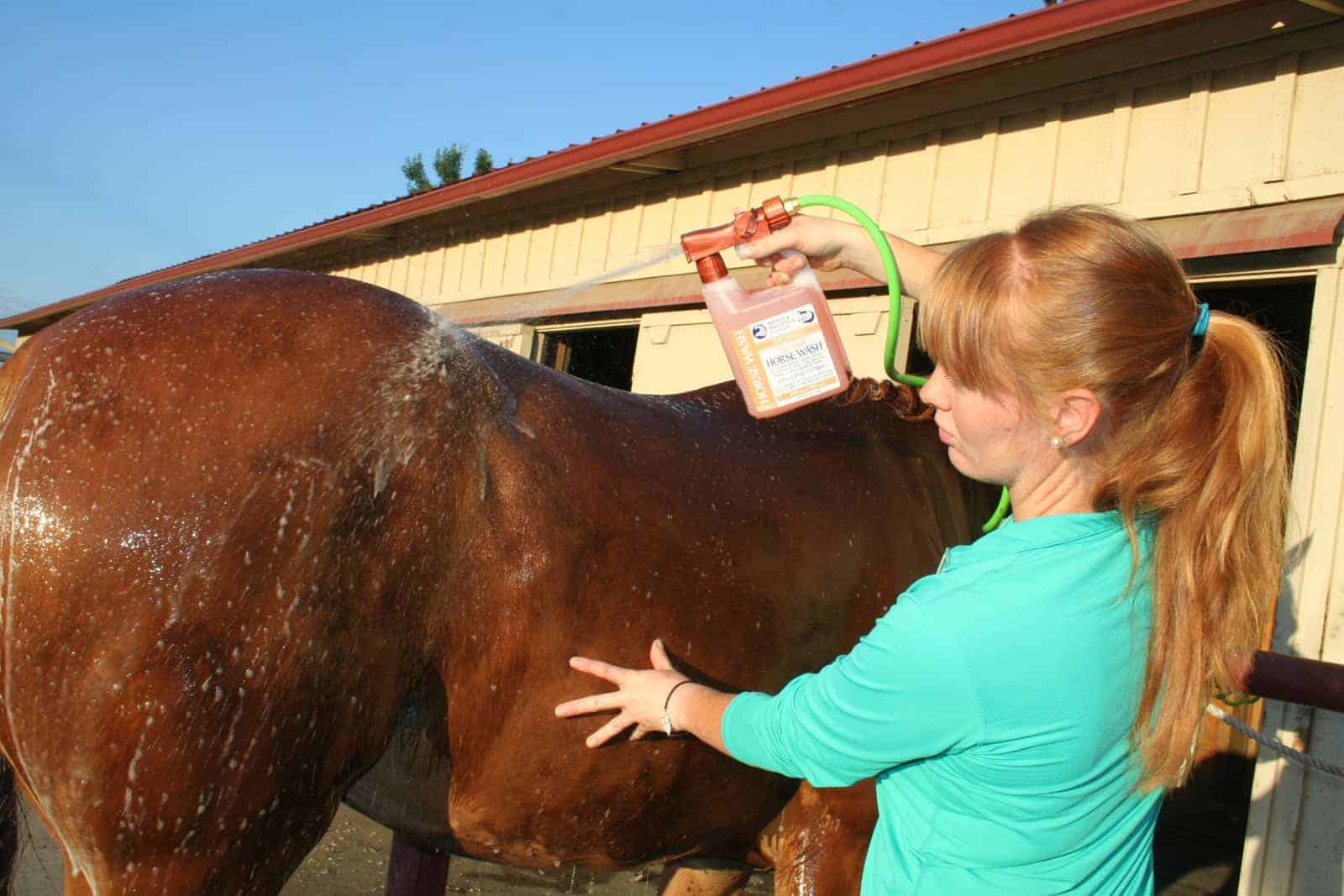
Shampoo
Mari uses a concentrated body wash with a built-in sprayer that produces suds at the flip of a dial. If you’re using another kind of shampoo, follow application instructions found on the bottle. Some are used full strength and others diluted. | Photo: Michelle N. Anderson, TheHorse.com Digital Managing Editor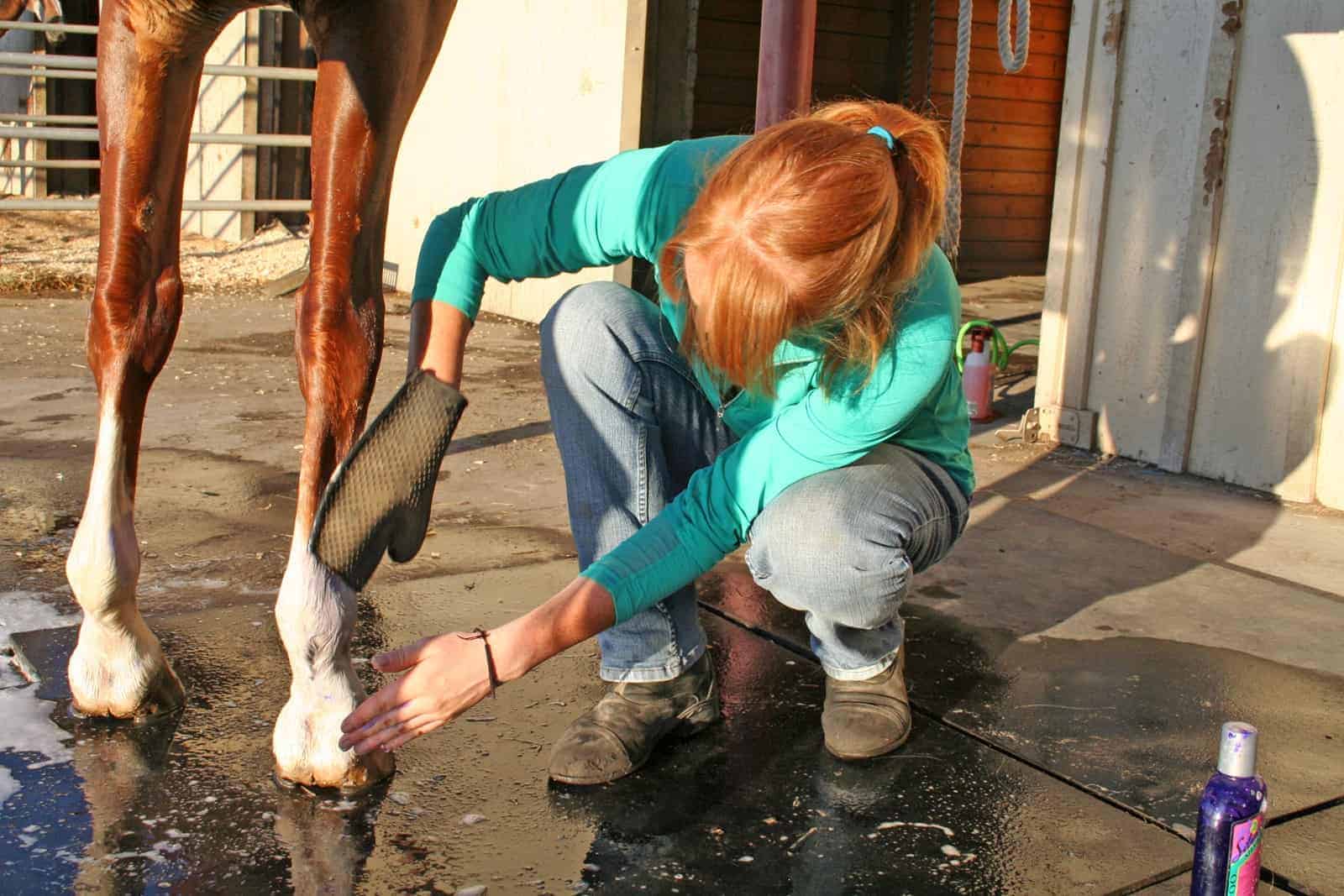
Bluing Shampoo
To wash Posey's white markings, Mari puts bluing shampoo on a rubber mitt and then uses the mitt to scrub the mare’s legs. The shampoo she’s using doesn’t require diluting; however, products vary, so make sure to follow the manufacturer’s instructions. | Photo: Michelle N. Anderson, TheHorse.com Digital Managing Editor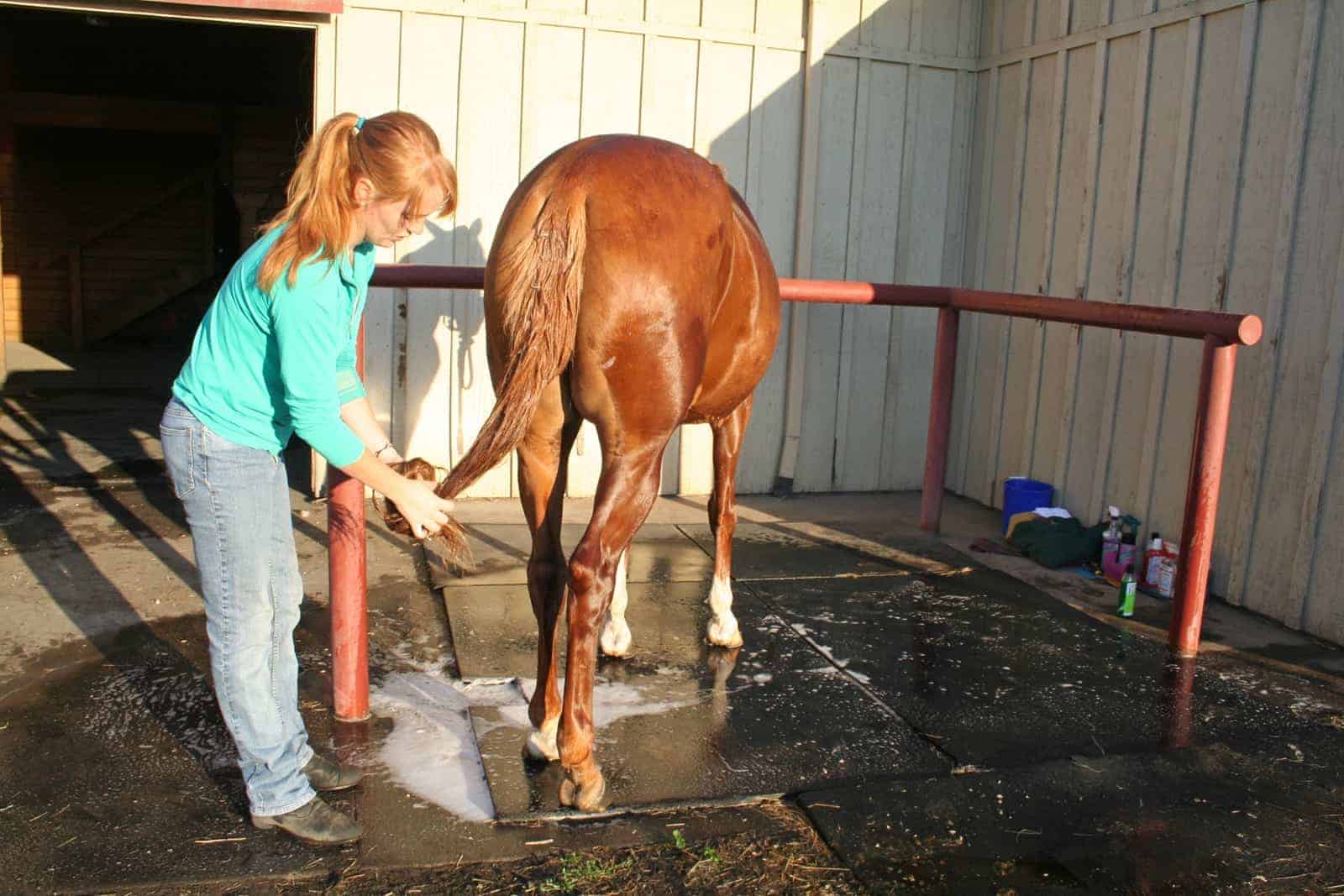
Mane and Tail
Mari uses a special volumizing shampoo on Posey's mane and tail. She takes extra care to massage shampoo into the mare’s tail dock using her fingers. | Photo: Michelle N. Anderson, TheHorse.com Digital Managing Editor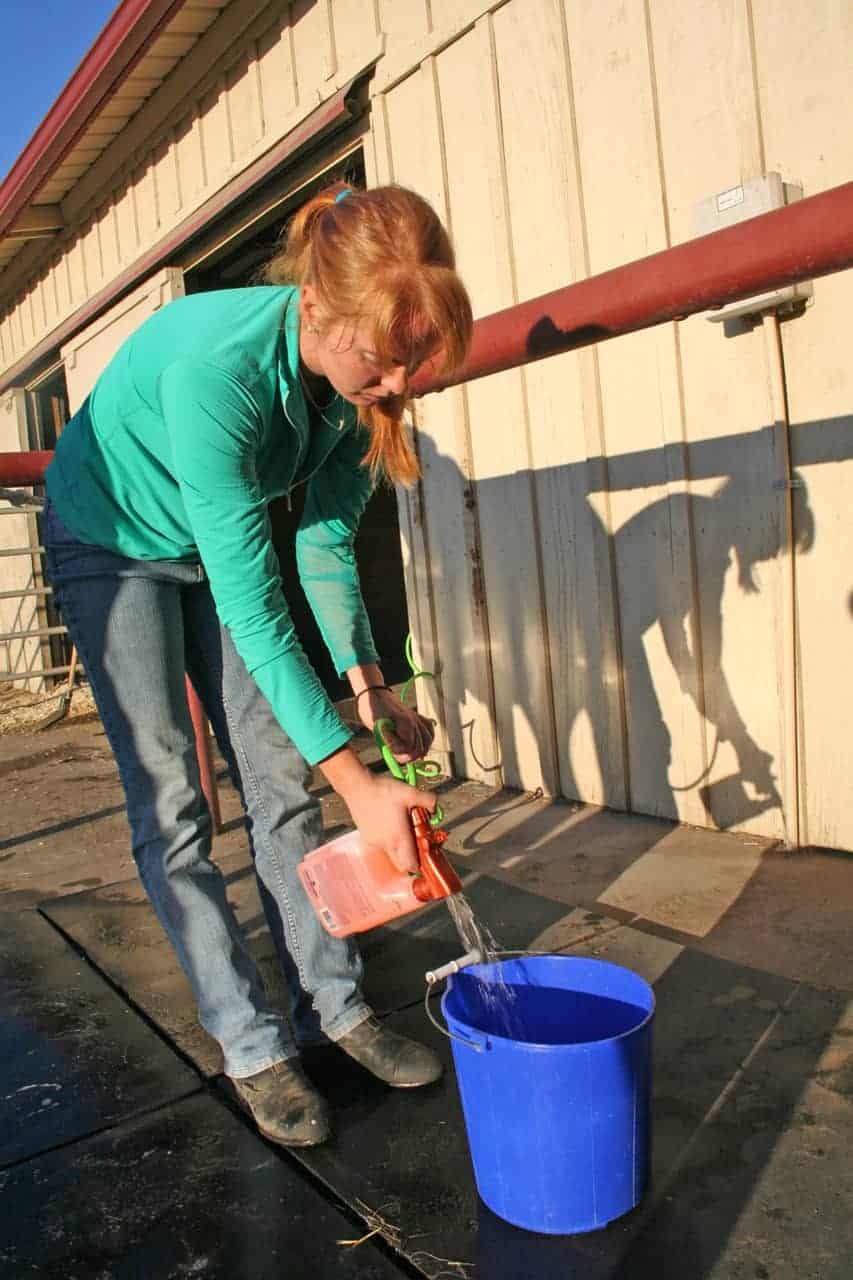
Washing the Face
Some horses tolerate having their faces gently sprayed with water on a low setting, but doing so can risk getting water and soap in a horse’s eyes and ears. Mari prefers to dilute gentle body wash or shampoo in a bucket … | Photo: Michelle N. Anderson, TheHorse.com Digital Managing Editor
Use a Sponge
… and uses a sponge to dampen the mare's face and forelock. If you’re not confident you can remove all the soap from your horse's face, Mari recommends skipping shampoo and using water only. A separate clean sponge or rag can be used to wash other delicate areas, such as the teats and vulva on a mare, or the outside of a gelding’s sheath. | Photo: Michelle N. Anderson, TheHorse.com Digital Managing Editor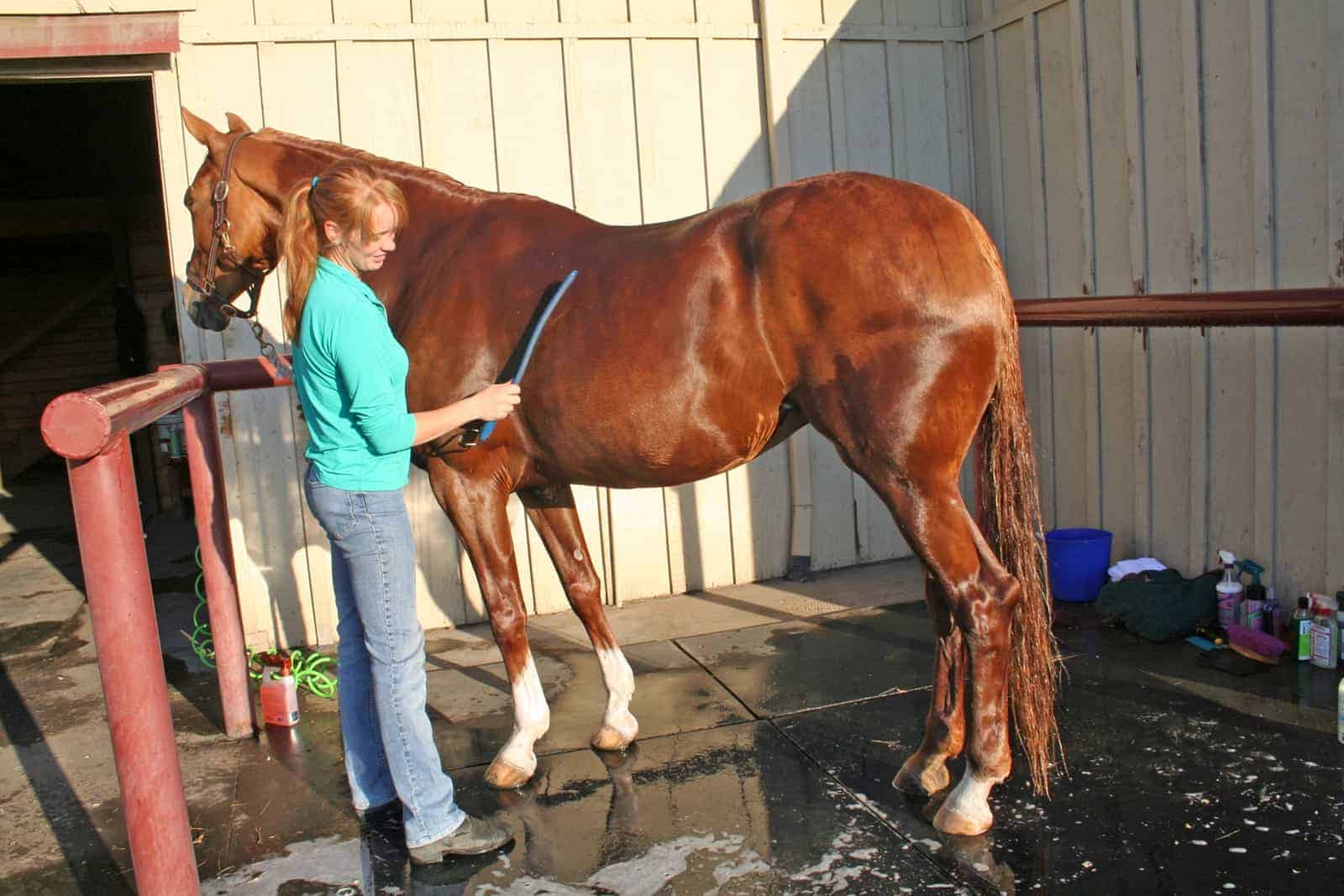
Rinse Thoroughly
Mari removes shampoo and body wash from Posey using the sprayer’s “rinse” function. As she rinses, she uses a sweat scraper to remove water. She continues rinsing until all signs of soap and suds are gone. | Photo: Michelle N. Anderson, TheHorse.com Digital Managing Editor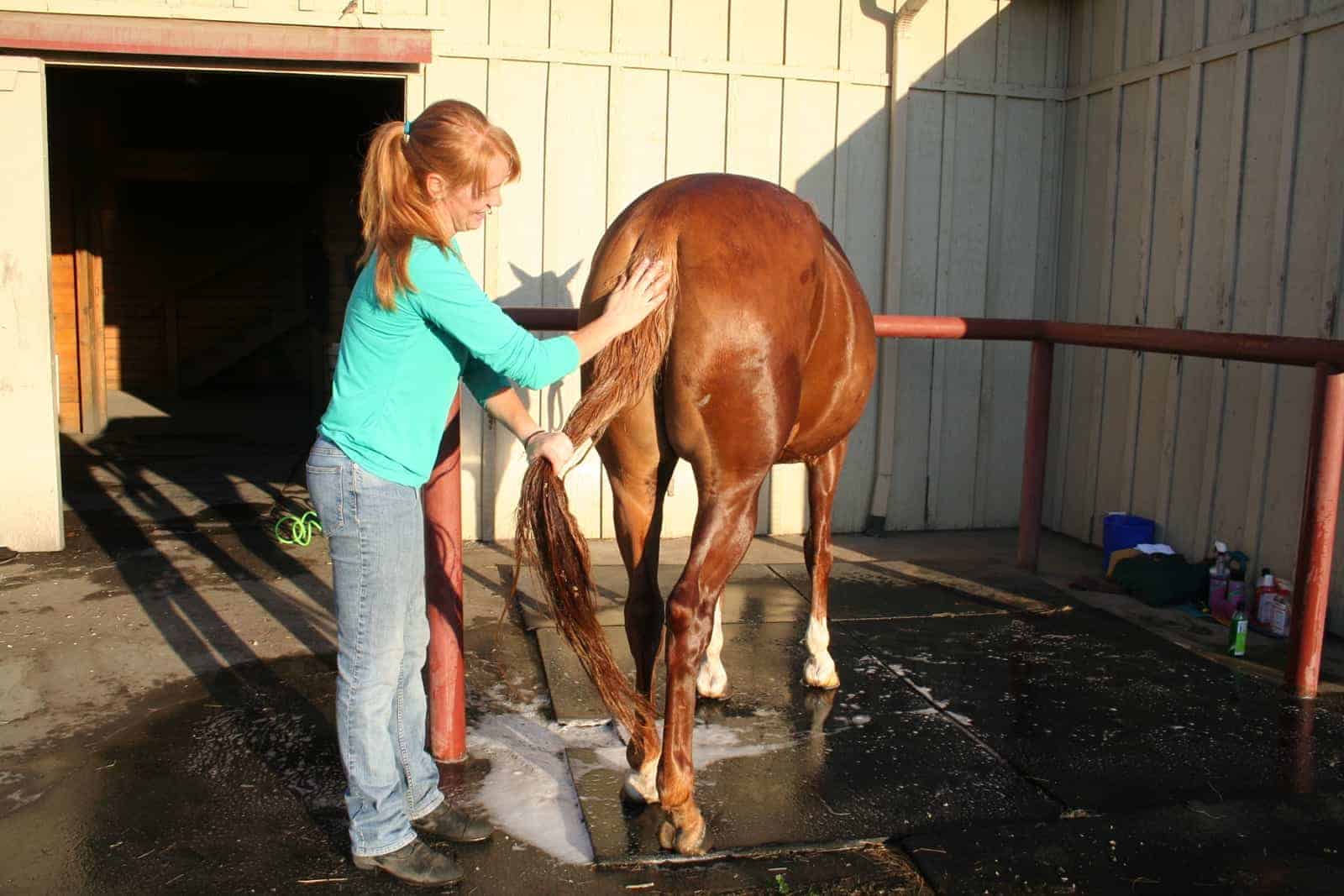
Rinse the Tail
Pay special attention to the horse's tail, Mari says. If any shampoo is left on the dock, the horse will likely itch, rub, and break tail hairs. | Photo: Michelle N. Anderson, TheHorse.com Digital Managing Editor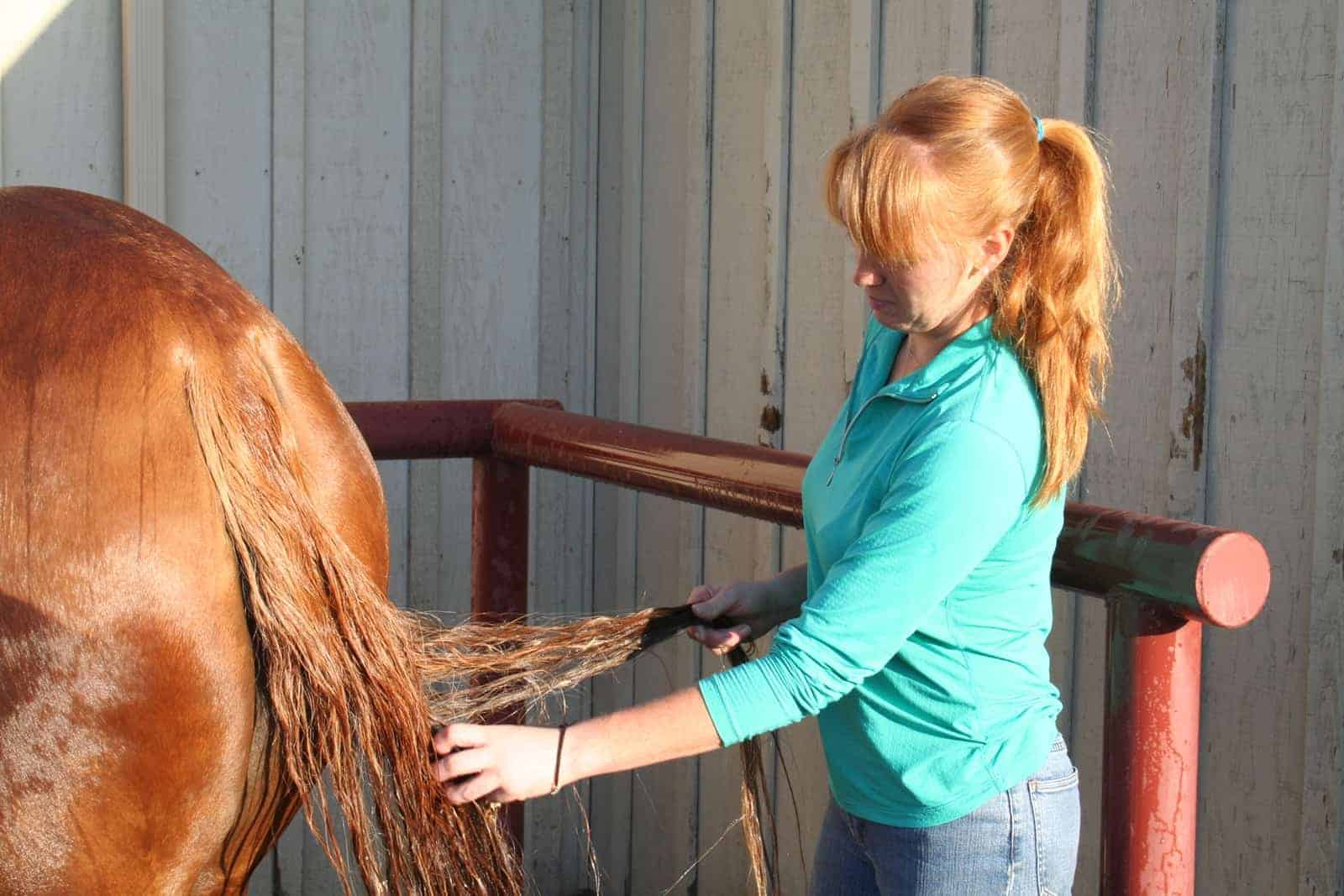
Condition the Tail
Mari applies a small amount of a leave-in conditioner to Posey's tail. Because Posey is a dressage horse and will likely get braided after her bath, Mari skips conditioning the mare's mane. This will make it easier to braid. However, she does apply mane conditioner to horses that have full manes or are not getting braided. | Photo: Michelle N. Anderson, TheHorse.com Digital Managing Editor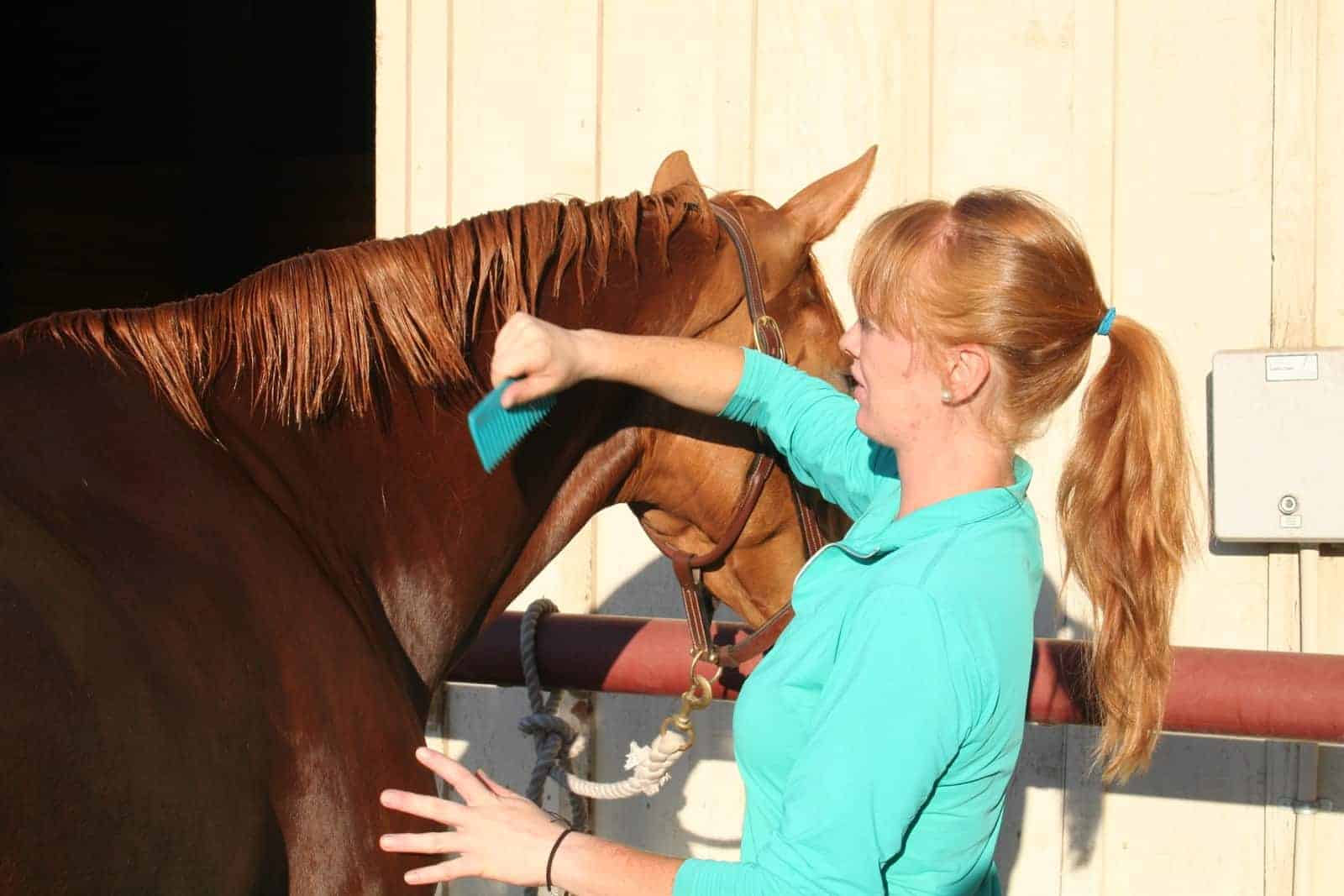
Use a Wide-Toothed Comb
To avoid breaking hairs, Mari doesn’t brush her horses' manes and tails on a regular basis, preferring to finger comb them instead. When they’re wet and slick with conditioner, however, she takes the opportunity to detangle manes and tails with a wide-toothed comb. | Photo: Michelle N. Anderson, TheHorse.com Digital Managing Editor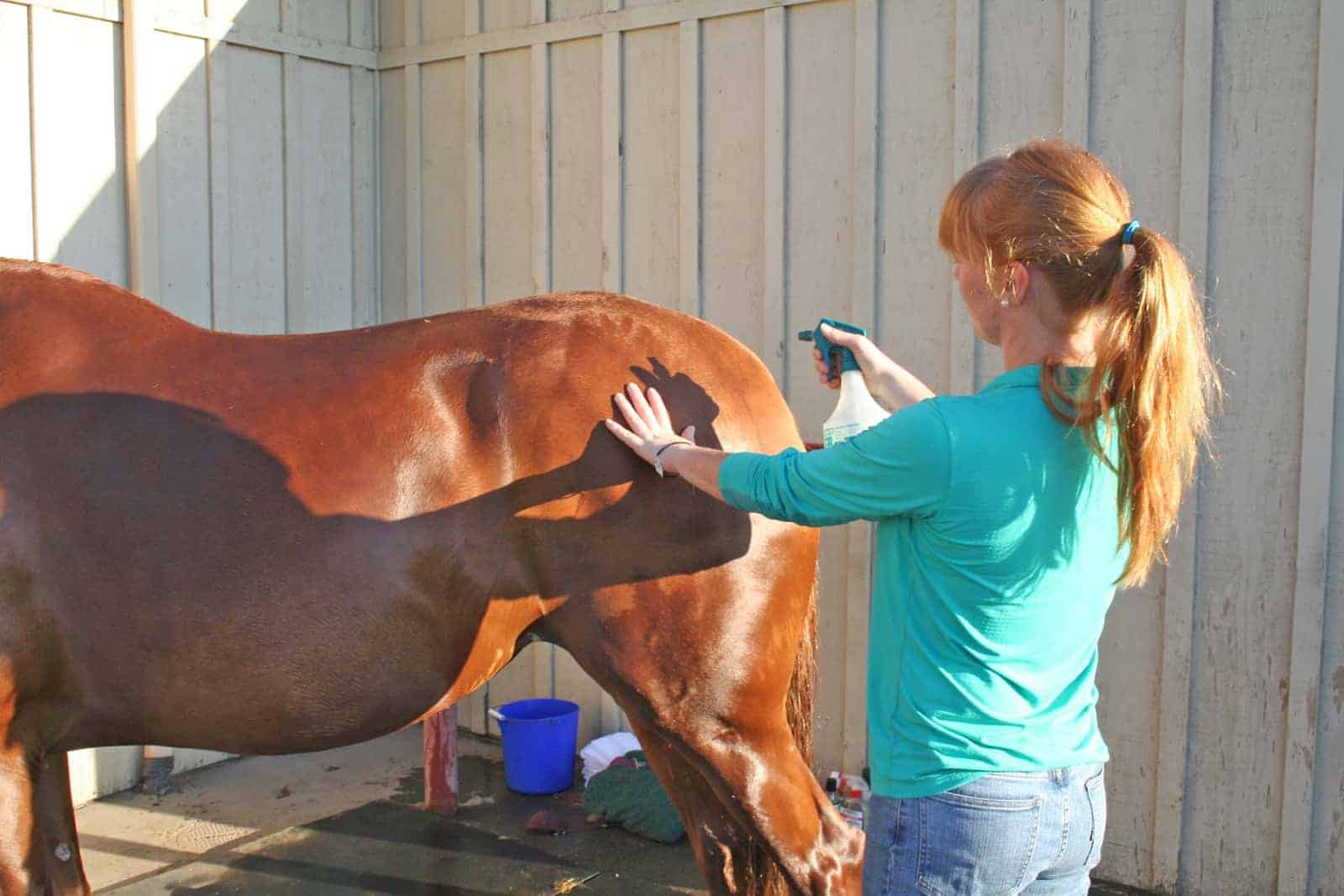
Apply a Coat Conditioner
For horses with dry coats or who get bathed often, such as those in the show string, Mari applies a conditioning spray. | Photo: Michelle N. Anderson, TheHorse.com Digital Managing Editor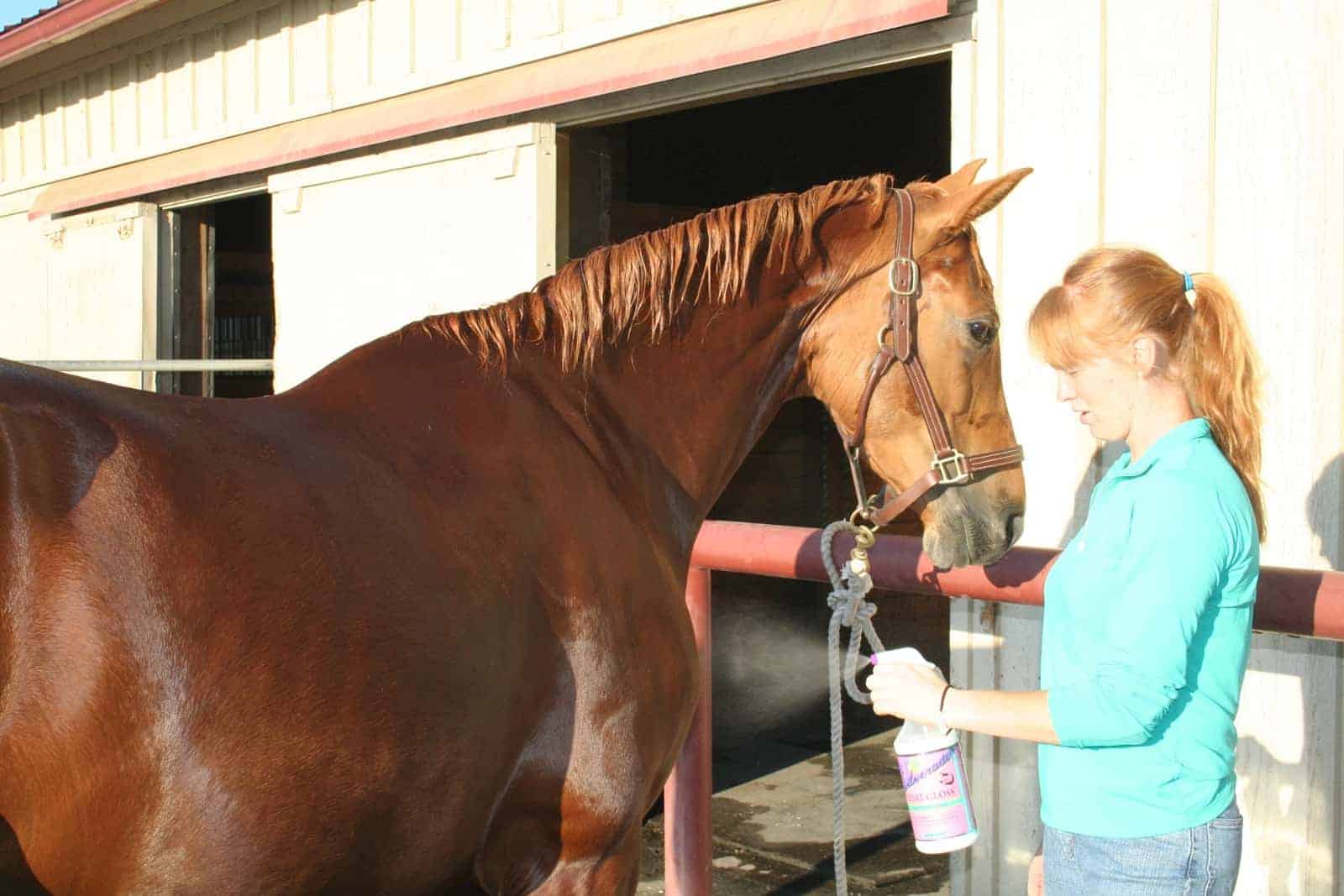
The Final Polish
Mari finishes Posey's bath with a polishing spray. Because it can make the coat slick as well as shiny, Mari avoids the mare’s saddle and girth areas. | Photo: Michelle N. Anderson, TheHorse.com Digital Managing Editor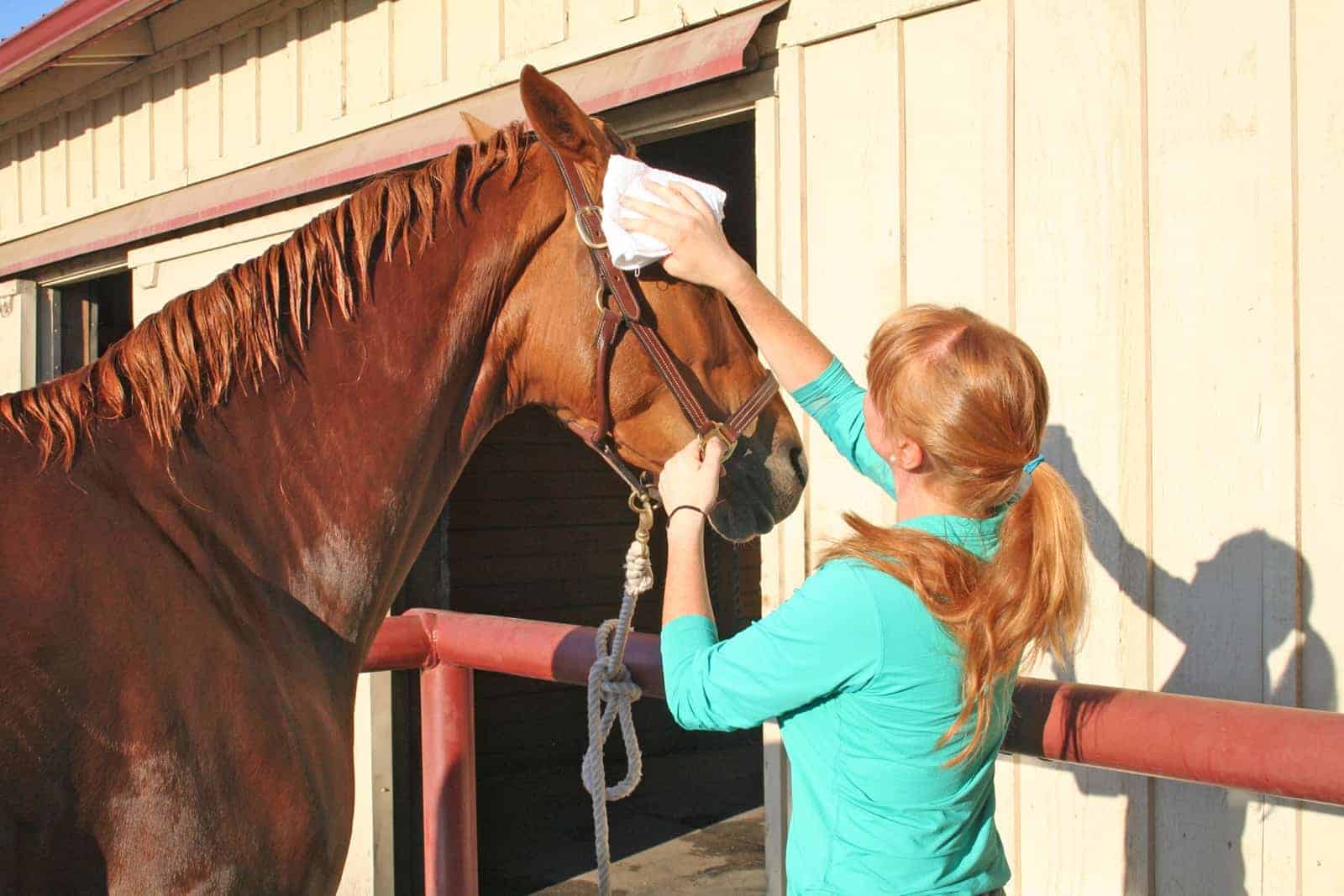
Applying Polish to the Face
As a finishing touch, Mari sprays coat polish on a clean cotton rag. She then gently uses the cloth to apply coat polish to the mare's face. | Photo: Michelle N. Anderson, TheHorse.com Digital Managing Editor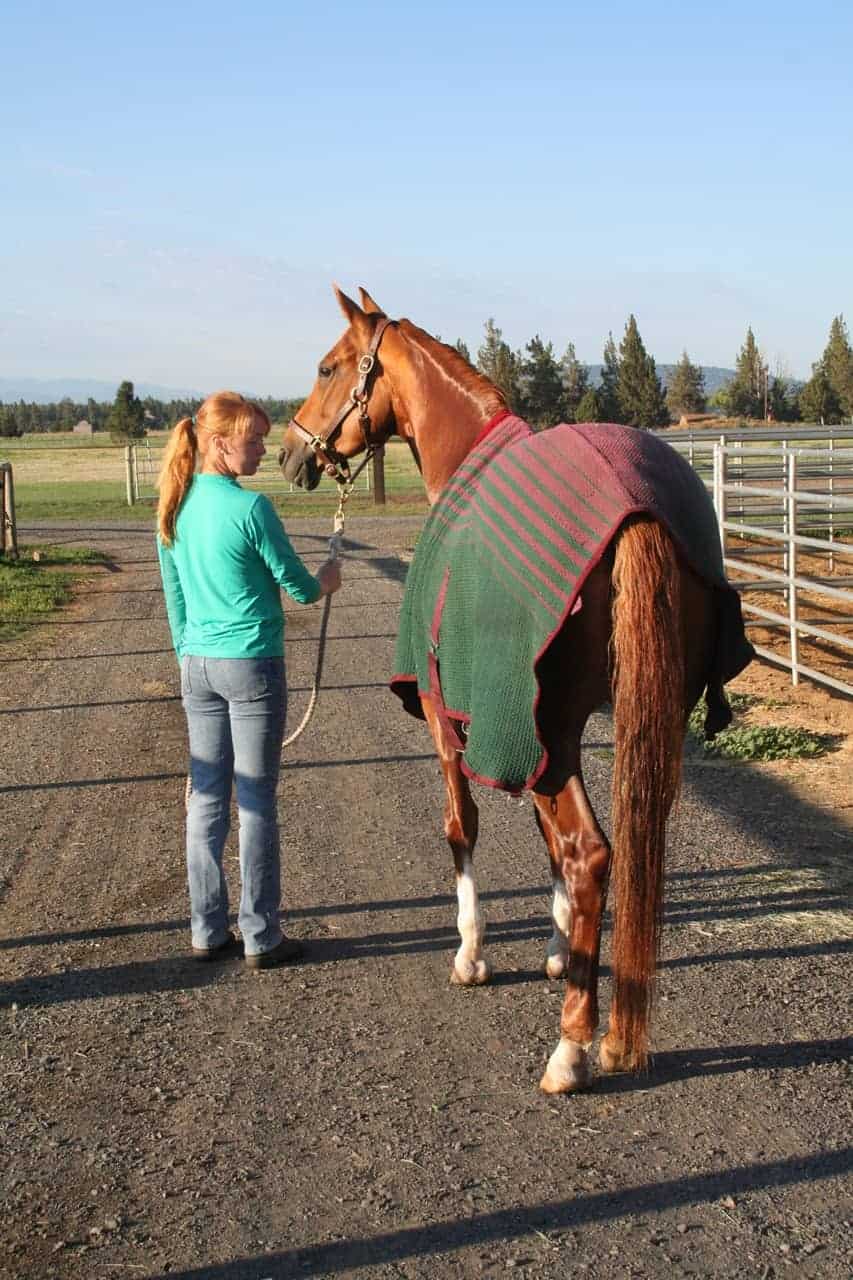
Apply a Sheet or Cooler
Mari puts a cotton scrim sheet on Posey and hand walks her while she dries. Doing so keeps the mare clean and prevents her from rolling while wet. Tip: Avoid using new sheets in bold colors on light colored horses, such as grays or pintos. The sheet’s color can bleed and stain the horse’s coat. | Photo: Michelle N. Anderson, TheHorse.com Digital Managing Editor
Share

The Horse: Your Guide To Equine Health Care is an equine publication providing the latest news and information on the health, care, welfare, and management of all equids.
Related Articles
Stay on top of the most recent Horse Health news with



